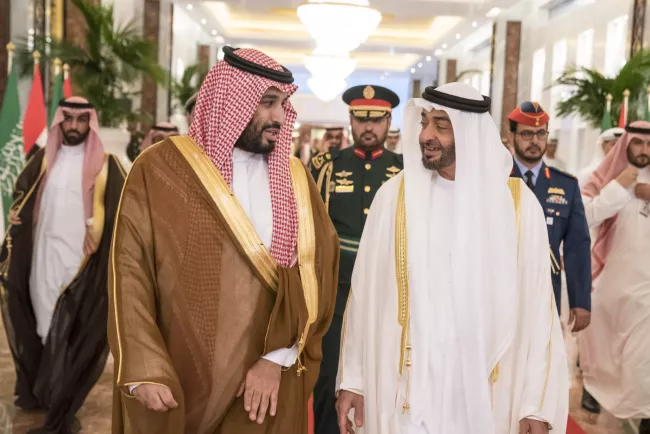
The Gulf’s moment is Saudi
Researcher and academic Abdulkhaleq Abdulla’s thesis about “the Gulf moment in contemporary history” (the title of his 2018 book) has sparked debate about the growing economic, political, social, cultural, and media influence of the Arab Gulf states across the Arab world over the past decade, following the decline of the old centers in Cairo, Baghdad, and Damascus.
There is no denying the many signs of Gulf states’ rising regional influence, especially Saudi Arabia, the United Arab Emirates, and Qatar, across multiple fields. These range from the World Cup and the impact of the Al Jazeera, Al Arabiya, and Sky News Arabia channels to cultural events like Riyadh Season, the Dubai Festival, and the Sharjah Book Fair. They also include military bases in Djibouti, Somaliland and Socotra, mediation in the Gaza Strip and the financing of future reconstruction there and in Syria and Lebanon, as well as the trajectory of the Abraham Accords and other initiatives.
Taken together, the three Gulf states have asserted their political, military, economic, cultural, and sporting presence.
Perhaps the fact that US President Donald Trump chose the three Gulf states for his first foreign visits in his second term in office, just as he opened his first term with a visit to Saudi Arabia in May 2017, underlined this importance and signaled the Gulf moment that Abdulkhaleq Abdulla discussed in his book.
Human capital and the kingdom’s opportunity
The Gulf states in general, and the trio of Saudi Arabia, the UAE, and Qatar in particular, have benefited from decades of planning and domestic political stability. They have achieved major economic and social gains by making optimal use of the vast oil wealth they possess.
Yet despite this, the potential Gulf moment looks set to be a distinctly Saudi one, not Qatari or Emirati. The three enjoy enormous financial power thanks to the surpluses generated by oil and gas exports, but Saudi Arabia has additional attributes that the other two lack, putting it in a better position to establish a political or security order in the region.
The first thing distinguishing Saudi Arabia from Qatar and the UAE is the relatively large size of its population, estimated at 35 million people, compared with 11 million in the UAE and around 3 million in Qatar. More significant still is the share of citizens in the total population in the three countries.
Non-citizen migrants made up about 51% of the total population of the six Gulf Cooperation Council states in 2020. The overall population of these states therefore does not reflect the number of citizens who can be relied on for military service and for projects that depend on local labor, especially since paths to naturalization are almost entirely closed to them.
In this regard, Saudi Arabia has the lowest share of foreigners to citizens among the Gulf states, at an estimated 32.7% of the total population in 2020, compared with the highest rates in the world for the UAE and Qatar, at 88.5% and 85.7% respectively.
This means both countries lack a core component of the modern nation-state: a people. This in turn closes the door to efforts like the Saudization program, which aims to raise Saudi nationals’ participation in the workforce and diversify the economy.
Bringing in migrant labor can compensate for the small size of the national workforce, but it cannot supply the other forms of power needed for regional influence, especially when it comes to military service. This is reflected in the size of the armed forces in the three countries: Saudi has about 257,000 personnel, compared with 63,000 for the UAE and 16,500 for Qatar.
Although the two countries are close in terms of military hardware, the gap between Saudi Arabia and the UAE is wide on Global Firepower’s military strength index: Saudi Arabia ranks 24th out of 145 countries, compared with 54th for the United Arab Emirates. This may simply reflect that a state needs people to drive its tanks and planes and fire its missiles, and ideally they should be citizens who owe it loyalty.
Arms, politics, and the economy
This may also be because Saudi Arabia’s defense budget for 2025, at about $74 billion, is roughly three times the projected spending for the UAE, at $23 billion, and for Qatar, at $9 billion. This in turn can be explained by the overall size of each of the three economies. Although average per capita income in Qatar and the UAE is among the highest in the world because of their small total populations and the small share of citizens among them, Saudi Arabia’s GDP is decisively larger than its two Gulf neighbors.
In 2024, the Saudi economy was among the world’s 20 largest and the largest in the Middle East and North Africa, at about $1.24 trillion, two and a half times the size of the Emirati economy at $537 billion and six times that of the Qatari economy at $217 billion.
This has made Saudi Arabia the Gulf’s sole member of the G20, where what counts is the overall weight of the economy, not per capita GDP. Indeed, one could say that the huge financial surpluses in some cases are the flip side of a hollowed-out demographic structure.
This brings us to other factors linked to recent developments in the region, especially since the beginning of the war on Gaza and the subsequent rapid shifts in Syria, Lebanon, Iran, and Yemen, which make Saudi Arabia the most likely candidate to seize the Gulf moment.
From the outset, the Gulf was not insulated from conflict in the region. Qatar quickly took center stage in mediation efforts over the Gaza Strip, while the outbreak of war was interpreted as an attempt to derail the Abraham Accords process, which the UAE had essentially led, and to block the path to normalizing relations between the kingdom and Israel.
Two years of military conflict have fractured what was once called the Iran-backed “axis of resistance.” By contrast, Turkey has expanded its presence in Syria, and perhaps in Gaza as well, while a renewed international consensus has emerged that a two-state solution is the only path to end the Israeli-Palestinian conflict, amid a noticeable shift in Western public opinion in both Europe and the United States.
The Palestine test
In light of these changes, which are redrawing the region’s geopolitical map, Saudi Arabia seems best placed to benefit. This is not only because of the attributes mentioned above, but also because it has shown a greater ability to pursue options that are relatively independent of US preferences in the region.
This was evident in Saudi Arabia’s joint leadership, alongside France, of the United Nations conference on a two-state solution, which played a key role in shifting the US position toward a cease-fire in Gaza and an end to Israel’s war on the Strip. Saudi Arabia’s contribution rested on its ability to reject any normalization with Israel without the establishment of a Palestinian state.
The two smaller Gulf states, however, remain firmly within the US sphere of influence. Their role takes one of two forms: serial mediations inside and outside the region—at times with Hamas, at times with the Taliban, at times in the Democratic Republic of Congo—a pattern that did not spare Qatar from Iranian and Israeli attacks in the same year; or a continued attachment to the Abraham Accords, which do not seem likely to recover from October 7, unless we take seriously the Trump administration’s celebration of Kazakhstan’s accession to the accords—which we should not.
The future of the Gaza Strip, and perhaps of the Palestinian question as a whole, is likely to hinge on several factors. One is an expanding Turkish role in filling the vacuum left by the collapse of the Iranian axis. Another is the revival of an Egyptian role in reconstruction in the Strip and its postwar administration, with some Gulf role in financing, whether from Qatar or the UAE. Saudi Arabia alone, however, will have room for political maneuver by tying any future normalization with Israel to a political settlement of the Palestinian issue.
I do not think that deploying financial surpluses in conflicts on the region’s margins in Libya, Sudan, the Horn of Africa, Mali, or Chad will provide adequate compensation for undermining the path of the Abraham Accords and shifting the decisive role in the file to Saudi Arabia, alongside efforts to rehabilitate Syria politically in the post-Assad era.
If we add to these elements Saudi Arabia’s religious influence the kingdom can exercise not only in shaping a political settlement in the region but also in steering cultural change in the Islamic world. This will only grow in importance as geopolitical competition between the United States and China intensifies, creating more room to maneuver for a state of Saudi Arabia’s size.

